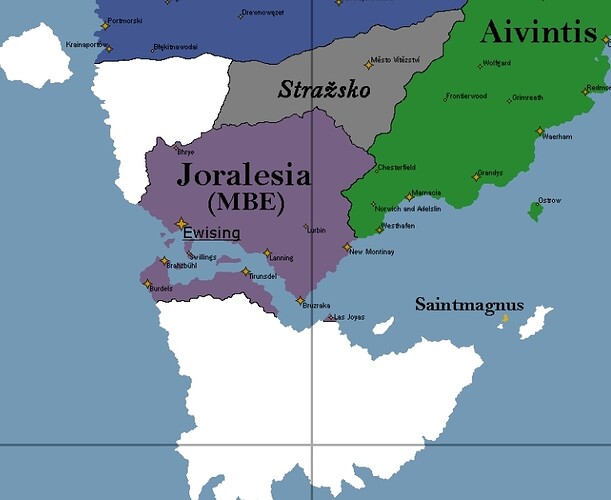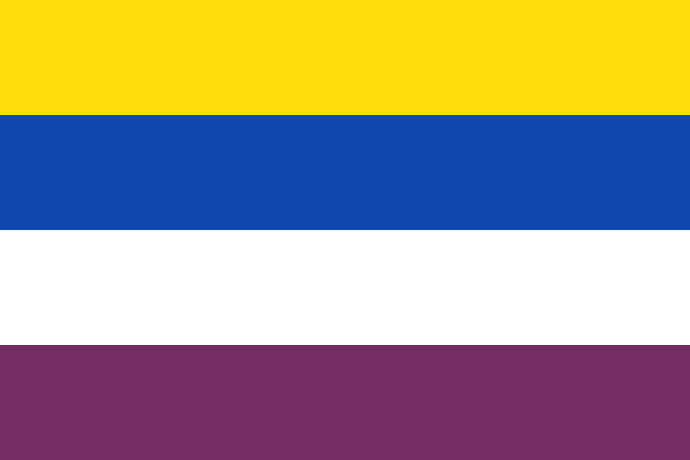I would ideally like the rest of this southern island if possible. Hlenderia is a sparsely populated nation dominated by taiga and wetland, with a middle income. If this is too large a claim, I’m happy to adjust it.
Flag:
Nation Name (long): The Hlenderian Commonwealth of Mūnim, Kwarim, and Vrotrim (formal), the Commonwealth of Hlenderia (informal)
Nation Name (short): Hlenderia
Motto: Hlenderia’s people are all alike in dignity.
National Animal: the fen-grouse, a large land grouse native to the fens and woods of inland Hlenderia.
Capitol: Pelachis, an ancient city situated on the Pela river.
Largest City: Norrith, a large port.
Demonym: Hlenderian
Language: The Hlenderian language is the only official language of the country, but Codexian is understood by many in the larger cities.
Species: Human
Population: The 2018 census lists 26 million souls in Hlenderia, the vast majority living in the coastal cities and Pelachis.
Government type: Hlenderia is a multi-ethnic state divided between the ethnic groups called Mūnim, Kwarim, and Vrotrim. These groups are connected by a common language, Hlenderian, and religion, though sectarian conflicts and feuds between them occur with semi-regularity over a variety of political and religious differences. Though called “ethnicities” by sociologists, geneologically they are closer to extended families, clans, or tribes.
Hlenderia’s political system is ostensibly an elective monarchy with a strong, but limited executive. In reality, political alliances between the Kwarim and Vrotrim have ensured that for the past century the throne has been held by someone from one of these groups.
Leader(s): King Yendrin Kwarrōth, an ethnic Kwari, has sat on the throne since 1991 and, while monarch, has embarked on a variety of modernization programs.
Legislature: The legislature of Hlenderia, known as the Grand Council, is democratically elected with seats apportioned to each ethnic group by their population. This can make census years times of strife and conflict. The legislature is weaker than the executive, but not a pure rubber-stamp, and can delay the monarch’s agenda.
Formation: the modern Hlenderian government was legally formed in 1687, after the rise of nationalism led the three major Hlenderian divisions to unite in response to foreign threats.
Total GDP: 494 billion. Major Hlenderian exports are lumber, seafood, and finished wood products.
GDP per capita: 19,000
Currency: Hlenderian dinar
Calling Code: HLE, .hl
Historical Summary: Hlenderia has been inhabited for thousands of years, but the three ethnic groups of the area were first recorded with their modern names about 1,500 years ago. The Mūnim, Kwarim, and Vrotrim would unite against foreign aggressors in their territory, but would just as often engage in conflicts between themselves for fishing and grazing rights or religious disagreements.
The Hlenderian religion, then and now, is a monotheistic folk religion with an emphasis on ancestor veneration. The Mūnim sect of this religion has always represented its most conservative form, and the Vrotrim sect the most iconoclastic, with the Kwarim sect oscillating between these two poles over the centuries.
Throughout antiquity and the medieval period, Hlenderia’s culture existed in this traditional form. By the middle of the medieval period, a locally-specific form of feudalism eventually emerged, which would lay the groundwork for the development of the contemporary Hlenderian government in the 17th century.
After repeated foreign incursions into their territory, the first Grand Council of the various Mūni, Kwari, and Vrotri clans united under a single leader of Mūni descent. Following victory in these wars, the form of government established to aid in organization persisted.
With the early development of capitalism and the urbanization of Hlenderia’s coastal settlements, the Kwari and Vrotri clans geographically situated near the coast rapidly gained wealth and political power. The Mūnim, located overwhelming in the vast, difficult to develop inland taiga, suffered amidst this transition and entered the industrial age with their traditional way of life threatened by encroachment from the coastal settlements.
This decline in political power, a wide fall from their first-among-equals status at the founding of the Commonwealth, continued in the early 20th century when political parties representing Kwari and Vrotri interests entered into an alliance ensuring their control of the throne for the foreseeable future. By the middle of the century, the Mūnim clans were at their nadir economically and politically.
The current King, Yendrin Kwarrōth, was elected by the Grand Council in 1991. Since his accession, Fendrin has embarked on a number of modernization programs, including infrastructure development in the interior and tourism funding - the latter a controversial investment in the famously insular Hlenderia. Conversely, however, Yendrin’s traditionalist religious outlook has seen him craft new alliances with Mūni politicians in the Grand Council, stressing his clan’s old alliance with the Vrotrim. The Mūnim, themselves, have seen their star improve in recent years. After the past two censuses, Mūni parties have been apportioned more seats in the legislature, reversing a decades-long decline. Falling birth rates on the more-developed coast, and improved healthcare in the interior due to Yendrin’s reforms, have widely been viewed as responsible for this change in fortunes.
Today, Yendrin is in his late seventies. His only daughter, Yendrina, would be seen as the heir apparent, but her claim to the throne faces challenges from the newly-ascendant Mūni parties and Vrotri elements in the government resentful of foreign investments changing coastal communities long under their sole political control.

